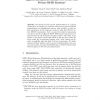283 search results - page 37 / 57 » Bi-Deniable Public-Key Encryption |
AAECC
2006
Springer
14 years 3 months ago
2006
Springer
The Fujisaki-Okamoto (FO) conversion is widely known to be able to generically convert a weak public key encryption scheme, say one-way against chosen plaintext attacks (OW-CPA), t...
CSFW
2000
IEEE
14 years 2 months ago
2000
IEEE
One protocol (called the primary protocol) is independent of other protocols (jointly called the secondary protocol) if the question whether the primary protocol achieves a securi...
ISW
2009
Springer
14 years 4 months ago
2009
Springer
As a new public key primitive, attribute-based encryption (ABE) is envisioned to be a promising tool for implementing fine-grained access control. To further address the concern o...
FC
2010
Springer
13 years 11 months ago
2010
Springer
We provide several concrete implementations of a generic method given by Vaudenay to construct secure privacy-preserving RFID authentication and identification systems. More precis...
TIT
2011
13 years 4 months ago
2011
Abstract. In 1998, Blaze, Bleumer, and Strauss proposed a cryptographic primitive called proxy re-encryption, in which a proxy transforms – without seeing the corresponding plain...

